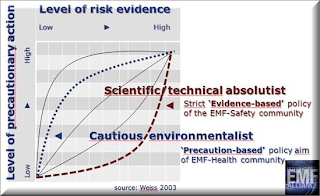Paradigma: due approcci alla definizione di regole ambientali
Qui allego un bel grafico preparato da IEMFA in cui si comparano i due approcci esistenti:
- quello rosso è quello di ICNIRP, WHO, EC , ... in cui si mantiene un basso livello di precauzione fino a che viene conclamato un alto livello di rischio: approccio tecnico scientifico assolutista, ovvero ... se non c'è un chiaro ed inequivocabile modello di causa effetto, si va avanti cosi' ...
- quello blu è di Bionititiative Report, IARC, IEMFA, ...ambientalista, cauto.
Ovviamente il primo è quello vincente !
Qui di seguito riporto le giuste considerazione di Alex (IEMFA) che fanno riflettere.
In sintesi, la popolazione ovviamente non ha alcuna informazione sui possibili danni, scientificamente ben descritti. Ma anche se lo sapesse ?
Facciamo un esempio: le auto. Quasi tutti noi usiamo l'auto. In Europa muoiono prematuramente 250.000 persone a causa dell'inquinamento dell'aria per PM10, NOx. E' stato accertato e riportato in documenti ufficiali del WHO. Sono state bloccate le auto ?!
Si richiama un poderoso studio della EEA Environmental Euporean Agency sulle lezioni tarde da segnali precoci provenienti dall'uso incauto di tecnologie quali quelle nucleari, biotecnologie, lo spostamento di specie da un continente ad un altro, i telefoni cellulari, le nanotecnologie.
E' uno studio prodotto dalla massima agenzia europea che deve dare indicazioni e guida alla Comunità Europea (che è quella che produce leggi e norme ambientali per tutti e 27 i paesi) ... eppure ? .... la Comunità Europea mantiene la barra dritta sul suo (o meglio di ICNIRP) paradigma tecnico-assolutista ! ...
_______________________________________________________________________________
- quello rosso è quello di ICNIRP, WHO, EC , ... in cui si mantiene un basso livello di precauzione fino a che viene conclamato un alto livello di rischio: approccio tecnico scientifico assolutista, ovvero ... se non c'è un chiaro ed inequivocabile modello di causa effetto, si va avanti cosi' ...
- quello blu è di Bionititiative Report, IARC, IEMFA, ...ambientalista, cauto.
Ovviamente il primo è quello vincente !
Qui di seguito riporto le giuste considerazione di Alex (IEMFA) che fanno riflettere.
In sintesi, la popolazione ovviamente non ha alcuna informazione sui possibili danni, scientificamente ben descritti. Ma anche se lo sapesse ?
Facciamo un esempio: le auto. Quasi tutti noi usiamo l'auto. In Europa muoiono prematuramente 250.000 persone a causa dell'inquinamento dell'aria per PM10, NOx. E' stato accertato e riportato in documenti ufficiali del WHO. Sono state bloccate le auto ?!
Si richiama un poderoso studio della EEA Environmental Euporean Agency sulle lezioni tarde da segnali precoci provenienti dall'uso incauto di tecnologie quali quelle nucleari, biotecnologie, lo spostamento di specie da un continente ad un altro, i telefoni cellulari, le nanotecnologie.
E' uno studio prodotto dalla massima agenzia europea che deve dare indicazioni e guida alla Comunità Europea (che è quella che produce leggi e norme ambientali per tutti e 27 i paesi) ... eppure ? .... la Comunità Europea mantiene la barra dritta sul suo (o meglio di ICNIRP) paradigma tecnico-assolutista ! ...
_______________________________________________________________________________
Most people are not trapped in the EMF paradigm. They do not know what is happening and still love their gadgets. Many things are happening in “our” World. Sometimes we do not know and many times we do not like to know it. For instance, most of us are driving and have a car. In Europe 250.000 people die earlier because we drive cars think about PM10 and NOx. Is this proven, yes. Do we stop driving a car, no? http://www.who.int/mediacentre/factsheets/fs313/en/index.html
“Urban outdoor air pollution is estimated to cause 1.3 million deaths worldwide per year. Those living in middle-income countries disproportionately experience this burden.”
“Urban outdoor air pollution is estimated to cause 1.3 million deaths worldwide per year. Those living in middle-income countries disproportionately experience this burden.”
Look also into the report of “Late lessons from early warnings: science, precaution, innovation” http://www.eea.europa.eu/publications/late-lessons-2
Politics will decide what will happen and industry will stretch their revenues so long as possible on our expenses and health.
For EMF there are enough reports with harmful effects. But till we know a mechanism nothing will change soon and if we know a mechanism EMF’s will stay but we will try to use it in a cleverer way. Like with the exhaust of cars, steering organisations will probably use damage control.
Important is that global population knows what is happening but not only about EMF’s but also all these other issues, chemicals, global warming, hormones, genetic modification, Nano technology and so on…….




chi vuole puo' scaricarsi una presentazione, in inglese, di Alex-IEMFA
RispondiEliminahttps://www.dropbox.com/s/r7rkpafbssuzsyq/iemfamadrid17may2012-paradigm.pdf